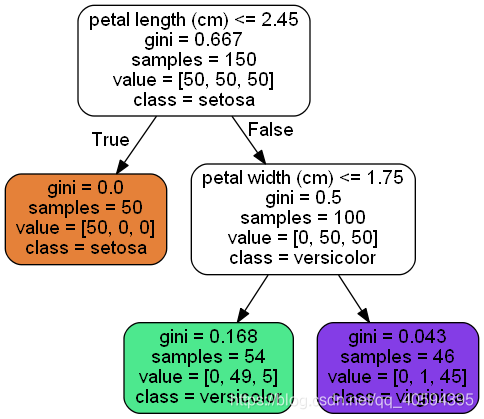决策树也像SVM一样能实现分类与回归(甚至多输出),能拟合复杂数据集。
本章将训练、可视化、预测决策树,介绍Scikit-Learn的CART算法,介绍正则化决策树并应用于回归,介绍决策树的部分限制。
Training and Visualizing a Decision Tree
构建决策树,了解其如何预测(load_iris):
from sklearn.datasets import load_iris
from sklearn.tree import DecisionTreeClassifier
iris = load_iris()
X = iris.data[:, 2:] # petal length and width
y = iris.target
tree_clf = DecisionTreeClassifier(max_depth=2, random_state=42)
tree_clf.fit(X, y)
可视化决策树:用export——graphviz()输出iris_tree.dot文件:
from sklearn.tree import export_graphviz
export_graphviz(
tree_clf,
out_file=image_path("iris_tree.dot"),
feature_names=iris.feature_names[2:],
class_names=iris.target_names,
rounded=True,
filled=True
)
用graphviz包(需要事先安装)dot命令转换格式:dot -Tpng iris_tree.dot -o iris_tree.png

Making Predictions
看图的话预测过程就比较清晰了,从根节点开始,先看花瓣长度是否<=2.45cm,然后跟着图的思路一步步到叶节点。
决策树的特质之一:需要数据准备非常少,完全不需要特征集中或缩放。
解释一下图中几个属性:
- samples:统计与应用的训练实例数量
- value:该节点上每个类别训练实例数量
- gini:不纯度(纯为0)
gini不纯度计算公式:pik:第i个节点上,类别为k的训练实例占比

Scikit-Learn使用CART算法仅生成二叉树;ID3生成决策树
看一下决策边界:
from matplotlib.colors import ListedColormap
def plot_decision_boundary(clf, X, y, axes=[0, 7.5, 0, 3], iris=True, legend=False, plot_training=True):
x1s = np.linspace(axes[0], axes[1], 100)
x2s = np.linspace(axes[2], axes[3], 100)
x1, x2 = np.meshgrid(x1s, x2s)
X_new = np.c_[x1.ravel(), x2.ravel()]
y_pred = clf.predict(X_new).reshape(x1.shape)
custom_cmap = ListedColormap(['#fafab0','#9898ff','#a0faa0'])
plt.contourf(x1, x2, y_pred, alpha=0.3, cmap=custom_cmap)
if not iris:
custom_cmap2 = ListedColormap(['#7d7d58','#4c4c7f','#507d50'])
plt.contour(x1, x2, y_pred, cmap=custom_cmap2, alpha=0.8)
if plot_training:
plt.plot(X[:, 0][y==0], X[:, 1][y==0], "yo", label="Iris-Setosa")
plt.plot(X[:, 0][y==1], X[:, 1][y==1], "bs", label="Iris-Versicolor")
plt.plot(X[:, 0][y==2], X[:, 1][y==2], "g^", label="Iris-Virginica")
plt.axis(axes)
if iris:
plt.xlabel("Petal length", fontsize=14)
plt.ylabel("Petal width", fontsize=14)
else:
plt.xlabel(r"$x_1$", fontsize=18)
plt.ylabel(r"$x_2$", fontsize=18, rotation=0)
if legend:
plt.legend(loc="lower right", fontsize=14)
plt.figure(figsize=(8, 4))
plot_decision_boundary(tree_clf, X, y)
plt.plot([2.45, 2.45], [0, 3], "k-", linewidth=2)
plt.plot([2.45, 7.5], [1.75, 1.75], "k--", linewidth=2)
plt.plot([4.95, 4.95], [0, 1.75], "k:", linewidth=2)
plt.plot([4.85, 4.85], [1.75, 3], "k:", linewidth=2)
plt.text(1.40, 1.0, "Depth=0", fontsize=15)
plt.text(3.2, 1.80, "Depth=1", fontsize=13)
plt.text(4.05, 0.5, "(Depth=2)", fontsize=11)

如图所示,2.45决策边界(深度为1),1.75决策边界(深度为2),若max_depth=3则dot-line将成为第三个决策边界。
决策树是白盒模型(直观容易解释),随机森林神经网络是黑盒模型(难以解释为什么这样预测)
Estimating Class Probabilities(估算类别概率):
决策树估算类别概率:找出类别k叶子节点:返回k实例占比:tree_clf.predict_proba([[5, 1.5]])
输出array([[0. , 0.90740741, 0.09259259]]),输出tree_clf.predict_proba([[6, 1.5]])结果相同。
The CART Training Algorithm
Scikit-Learn使用的是分类与回归树(Classification And Regression Tree——CART)训练决策树(生长树):首先使用特征k和阈值tk训练成两个子集,k,tk的选择:最纯子集(加权)的k,tk,算法函数:

- Gleft/right:衡量左右子集的不纯度
- mleft/right:左/右子集实例数量
分裂子集直至抵达max_depth,或再也找不到能够降低不纯度的分裂,附加停止条件(min_samples_split, min_samples_leaf, min_weight_fraction_leaf, and max_leaf_nodes)
CART是贪婪算法:从顶层开始搜索最优分裂,每层重复,但不保证是最优解。而且寻找最优树是NP完全问题(NP:能在多项式时间内验证正确,L 是NP-Hard,任何一个NP问题都可以在多项式时间内被规划成L问题,NP完全:既是NP又是NP-Hard),所以必须接受CART是一个相对不错解。
Computational Complexity
预测是从根到叶:O(log2(m))个节点,与特征数量无关。
但训练是要在所有样本上比较所有特征(除非设置max_features),导致复杂度O(n*m log(m))小型数据集可以通过设置 presort = "true"来解决,大型就得放缓速度。
Gini Impurity or Entropy?(Gini不纯度还是信息熵?)
默认是gini 不纯度来测量,可以通过 criterion = "entropy"来选择信息熵做不纯度测量,计算:

Regularization Hyperparameters(正则化超参数)
决策树很少对训练数据做假设(线性模型相反,假设线性)。非参数模型:如果不限制,树结构将随训练集变化,便过拟合。(训练前没有确定参数数量,即过度拟合)
所以需要降低决策树自由度——正则化。正则化超参数取决于所用模型,例如max_depth,减小max_depth可使模型正则化,降低过度拟合风险。
其他参数:
- min_samples_split:分裂前必须有的最小样本数量
- min_samples_leaf:叶子节点必须有的最小样本数量
- min_weight_fraction_leaf:叶子节点必须有的最小样本占比
- max_leaf_nodes:最大叶节点数量
- max_features:分裂每个节点评估的最大特征数量
还有一种正则化:先不加约束训练,再对不必要节点删除:若一个节点子节点全为叶节点,则没必要(除非有利于提纯);标准统计测试,如 χ2测试(估算提纯出于偶然——虚假设)概率,高于阈值,子节点可删。直至所有不必要节点都被删掉。
from sklearn.datasets import make_moons
Xm, ym = make_moons(n_samples=100, noise=0.25, random_state=53)
deep_tree_clf1 = DecisionTreeClassifier(random_state=42)
deep_tree_clf2 = DecisionTreeClassifier(min_samples_leaf=4, random_state=42)
deep_tree_clf1.fit(Xm, ym)
deep_tree_clf2.fit(Xm, ym)
plt.figure(figsize=(11, 4))
plt.subplot(121)
plot_decision_boundary(deep_tree_clf1, Xm, ym, axes=[-1.5, 2.5, -1, 1.5], iris=False)
plt.title("No restrictions", fontsize=16)
plt.subplot(122)
plot_decision_boundary(deep_tree_clf2, Xm, ym, axes=[-1.5, 2.5, -1, 1.5], iris=False)
plt.title("min_samples_leaf = {}".format(deep_tree_clf2.min_samples_leaf), fontsize=14)

右图应用min_samples_leaf =4,明显泛化更好,左图过拟合。
Regression
决策树回归:例:Scikit-Learn的DecisionTreeRegressor(max_depth= 2)加噪声的二次数据集训练:
构建数据集:
# Quadratic training set + noise
np.random.seed(42)
m = 200
X = np.random.rand(m, 1)
y = 4 * (X - 0.5) ** 2
y = y + np.random.randn(m, 1) / 10
训练模型:
from sklearn.tree import DecisionTreeRegressor
tree_reg = DecisionTreeRegressor(max_depth=2, random_state=42)
tree_reg.fit(X, y)

结果树如图,跟分类树相似,差别是从预测一个结果转变为预测一个值。例:x1 = 0.6 到value = 0.1106的叶节点,预测结果为此节点110个实例平均值。测出MSE = 0.0151.
from sklearn.tree import DecisionTreeRegressor
tree_reg1 = DecisionTreeRegressor(random_state=42, max_depth=2)
tree_reg2 = DecisionTreeRegressor(random_state=42, max_depth=3)
tree_reg1.fit(X, y)
tree_reg2.fit(X, y)
def plot_regression_predictions(tree_reg, X, y, axes=[0, 1, -0.2, 1], ylabel="$y$"):
x1 = np.linspace(axes[0], axes[1], 500).reshape(-1, 1)
y_pred = tree_reg.predict(x1)
plt.axis(axes)
plt.xlabel("$x_1$", fontsize=18)
if ylabel:
plt.ylabel(ylabel, fontsize=18, rotation=0)
plt.plot(X, y, "b.")
plt.plot(x1, y_pred, "r.-", linewidth=2, label=r"$\hat{y}$")
plt.figure(figsize=(11, 4))
plt.subplot(121)
plot_regression_predictions(tree_reg1, X, y)
for split, style in ((0.1973, "k-"), (0.0917, "k--"), (0.7718, "k--")):
plt.plot([split, split], [-0.2, 1], style, linewidth=2)
plt.text(0.21, 0.65, "Depth=0", fontsize=15)
plt.text(0.01, 0.2, "Depth=1", fontsize=13)
plt.text(0.65, 0.8, "Depth=1", fontsize=13)
plt.legend(loc="upper center", fontsize=18)
plt.title("max_depth=2", fontsize=14)
plt.subplot(122)
plot_regression_predictions(tree_reg2, X, y, ylabel=None)
for split, style in ((0.1973, "k-"), (0.0917, "k--"), (0.7718, "k--")):
plt.plot([split, split], [-0.2, 1], style, linewidth=2)
for split in (0.0458, 0.1298, 0.2873, 0.9040):
plt.plot([split, split], [-0.2, 1], "k:", linewidth=1)
plt.text(0.3, 0.5, "Depth=2", fontsize=13)
plt.title("max_depth=3", fontsize=14)

若设max_depth = 2,则是右图,预测值为该区域实例目标平均值,算法分裂实质就是更接近预测值。
CART原理也是这样,但它分裂训练集方式是最小化MSE,而不是最小化不纯度,下图为最小化不纯度成本函数:

无论是回归还是分类,都很容易过拟合。

如图所示,左图过拟合,右图设置max_samples_leaf = 10后后很多。
代码:
tree_reg1 = DecisionTreeRegressor(random_state=42)
tree_reg2 = DecisionTreeRegressor(random_state=42, min_samples_leaf=10)
tree_reg1.fit(X, y)
tree_reg2.fit(X, y)
x1 = np.linspace(0, 1, 500).reshape(-1, 1)
y_pred1 = tree_reg1.predict(x1)
y_pred2 = tree_reg2.predict(x1)
plt.figure(figsize=(11, 4))
plt.subplot(121)
plt.plot(X, y, "b.")
plt.plot(x1, y_pred1, "r.-", linewidth=2, label=r"$\hat{y}$")
plt.axis([0, 1, -0.2, 1.1])
plt.xlabel("$x_1$", fontsize=18)
plt.ylabel("$y$", fontsize=18, rotation=0)
plt.legend(loc="upper center", fontsize=18)
plt.title("No restrictions", fontsize=14)
plt.subplot(122)
plt.plot(X, y, "b.")
plt.plot(x1, y_pred2, "r.-", linewidth=2, label=r"$\hat{y}$")
plt.axis([0, 1, -0.2, 1.1])
plt.xlabel("$x_1$", fontsize=18)
plt.title("min_samples_leaf={}".format(tree_reg2.min_samples_leaf), fontsize=14)
Instability(不稳定性)
决策树容易解释理解,功能也很强大,但也有限制:对决策边界非常敏感,所以如果训练集旋转,则预测可能发生很大改变,改变这种现象就得使用PCA。

其实说敏感,敏感的是训练数据小变化,如果把最卷的V花删了,则重新训练

与以前训练(下图)差距很大。。
因为Scikit-Learn算法随机,所以相同训练数据,模型都可能完全不同(除非设置random_state)
下账将看到随机森林对多个树预测平均,限制不稳定性。





















 4190
4190











 被折叠的 条评论
为什么被折叠?
被折叠的 条评论
为什么被折叠?








